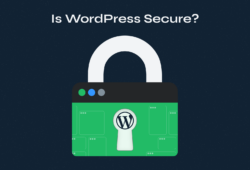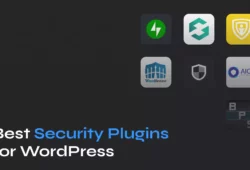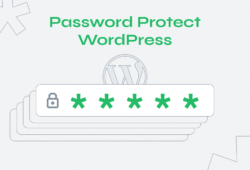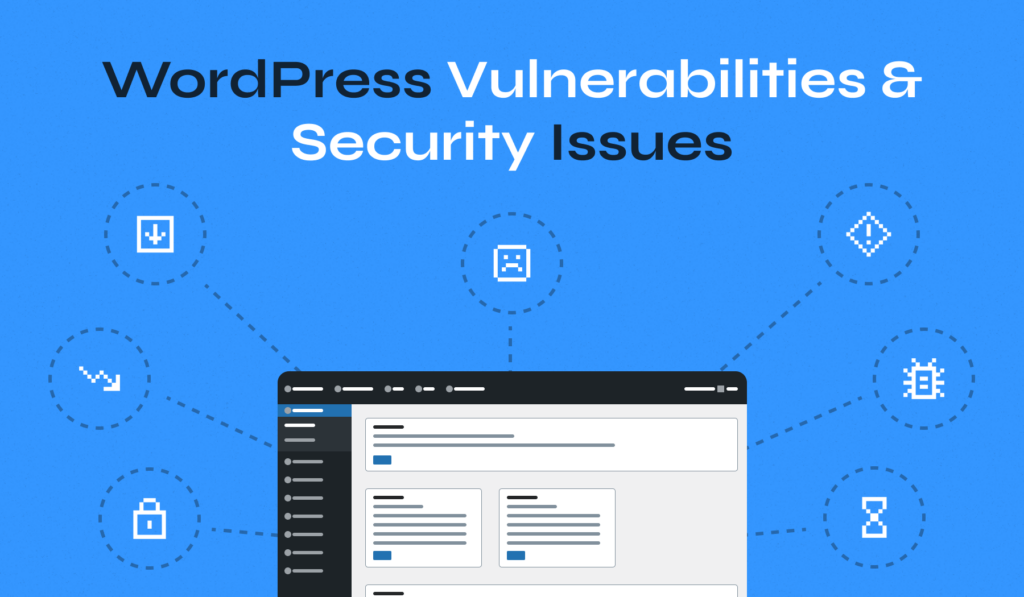
WordPress security is a critical concern for all site owners, from beginners to experienced developers. In this article, we’ll explore the most common WordPress security issues and vulnerabilities, as well as the major security threats targeting WordPress sites.
First, we’ll examine common security issues that can arise within a WordPress site, such as outdated software and insecure permissions. Then, we’ll discuss the external threats that target WordPress sites, including malware, brute force attacks, and phishing.
By understanding these vulnerabilities and implementing the recommended solutions, you can safeguard your website against cyber-attacks, data breaches, and other malicious activities, ensuring a secure and trustworthy online environment for your users.
9 WordPress Security Issues and How to Fix Them
Vulnerabilities often emerge from outdated software, poor configurations, or even overlooked settings. Let’s examine how to mitigate these common security issues affecting WordPress sites.
1. Outdated Core Software, Plugins, and Themes
All software has vulnerabilities, including the core WordPress software, plugins, and themes. As these security vulnerabilities become known, WordPress developers release updates to patch them. Failing to update your WordPress website components exposes your site, providing hackers with easy access points to exploit.
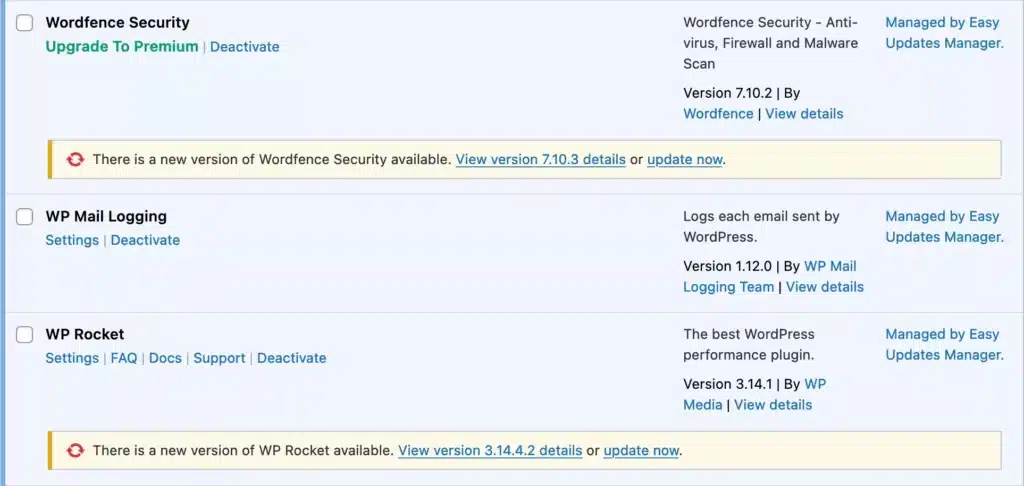
Regular updates are not just about adding new features or improving performance; they are a critical security measure. By consistently monitoring and updating, you ensure your website benefits from the latest WordPress security patches, keeping potential threats at bay.
Best Practices and Solutions:
- Apply security updates regularly to WordPress core, plugins, and themes. Before updating, check for compatibility to avoid potential issues.
- Review and remove any plugins or themes that are no longer maintained by their developers.
- Use monitoring services or plugins that notify you of available updates or potential WordPress vulnerabilities.
- Schedule regular maintenance checks to ensure all components are up to date.
2. Lack of WordPress Security Plugins
A lack of WordPress security plugins can leave your site vulnerable to many threats and attacks. Security plugins are essential tools that provide critical protective measures to fortify your site against potential security breaches. These plugins offer a range of features, including malware scanning, firewall protection, brute-force attack prevention, security auditing, and real-time monitoring. Without these tools, identifying and mitigating WordPress security risks becomes significantly more challenging, exposing your site to various cyberattacks.
Security plugins not only help detect and block malicious activities but also offer insights into your website’s security posture. They can alert you to outdated software, suspicious login attempts, and unauthorized changes to your files. Without these proactive measures, your site remains an easy target for attackers who can exploit vulnerabilities, compromise user data, and cause significant disruptions.
Best Practices and Solutions:
- Install reputable WordPress security plugins like Wordfence, All-In-One Security (AIOS), or Jetpack Protect.
- Keep your security plugins updated to protect against the latest threats.
- Configure plugins to run regular scans and send alerts for suspicious activities.
- Use multiple security plugins with complementary features for comprehensive protection.
3. Lack of Regular Site Backups
Regular backups are a critical component of any WordPress site’s security strategy. Without consistent backups, recovering from a security breach, server failure, or accidental data loss becomes significantly more challenging, if not impossible. Backups ensure you have a recent copy of your site’s files and database that can be restored quickly, minimizing downtime and data loss.
Failing to perform regular backups can leave your site vulnerable to prolonged outages and loss of crucial data. In a cyberattack, such as a ransomware infection or a destructive hack, backups are often the only way to restore your site to its previous state. Additionally, backups are essential for recovery in accidental deletions, corrupt updates, or host failures.
Best Practices and Solutions:
- Schedule automated backups to run daily or weekly, depending on your site’s update frequency.
- Use reputable backup plugins like UpdraftPlus, Duplicator, or WP STAGING to simplify the backup process.
- Store backups in multiple locations, such as on your server, a remote cloud service, and offline storage.
- Keep multiple backup versions to allow recovery from different points in time.
- Document and regularly update your backup procedures as part of your overall disaster recovery plan.
4. Untrusted Themes and Plugins
WordPress offers a wide variety of plugins and themes. With some premium options coming with a hefty price tag, the allure of “nulled” (or pirated) versions of these tools can be tempting. However, these unauthorized versions often contain hidden malicious code that can have severe implications.
Nulled plugins or themes might actually be Trojan horses, seemingly beneficial due to their “free” status. Users could unknowingly install them and add backdoors, spyware, or SEO spam to their websites.
Spotting the Red Flags:
- The source site seems dubious or unfamiliar.
- The WordPress plugin/theme is offered for free, but it’s typically a premium product.
- User reviews or comments indicate unexpected behaviors or security issues after installation.
Deploying untrusted software can lead to many problems, from simple spam ads popping up on your website to severe WordPress security issues like data theft, unauthorized changes to your site’s appearance, or even a complete site takeover.
Best Practices and Solutions:
- Always download plugins and themes from reputable sources, like the official WordPress repository or trusted developers like WPZOOM.
- Keep a regular check on your website for unexpected changes or activities.
- Regularly update all plugins and themes to ensure they include the latest security patches.
- Remove any plugins or themes that are no longer maintained by their developers.
- Read reviews and research any plugin or theme before installation to ensure it has a good track record and is trusted by the community.
- Avoid using plugins and themes from sources that distribute pirated or nulled versions of premium products.
5. Undefined User Roles
Every user on your WordPress site should have a defined role: administrator, editor, or subscriber. Not setting clear user roles and permissions can be likened to having an open-door policy at a secure facility—anyone can walk in and access areas they shouldn’t.
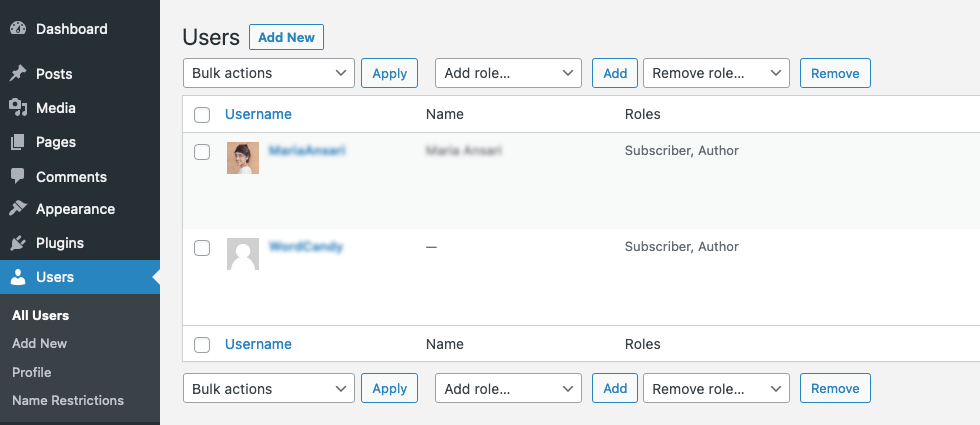
If user roles aren’t tightly defined, it opens avenues for misuse. A user with too many privileges might unknowingly make harmful changes. Worse, these undefined roles could lead to intentional harm or data breaches in the hands of someone with malicious intent. Clear and specific user roles help maintain order and security, ensuring users can only access what they need to perform their tasks.
Best Practices and Solutions:
- Regularly audit user roles, ensuring users have only the permissions they need.
- Limit the number of administrators on your site. Only some people need full access.
- Establish a policy for creating and managing user accounts, including guidelines for assigning roles and permissions.
- Implement two-factor authentication (2FA) for administrator accounts to add an extra layer of security.
- Regularly review and update user roles and permissions as your site evolves to ensure they remain appropriate.
6. Exposed wp-config.php File
The WordPress configuration file, wp-config.php, is one of the most critical files in your WordPress installation. It houses sensitive data like database connection details, unique security keys, and other important configuration settings. In essence, it’s the guide to your site’s backend, containing information essential for WordPress to communicate with the database and function properly.
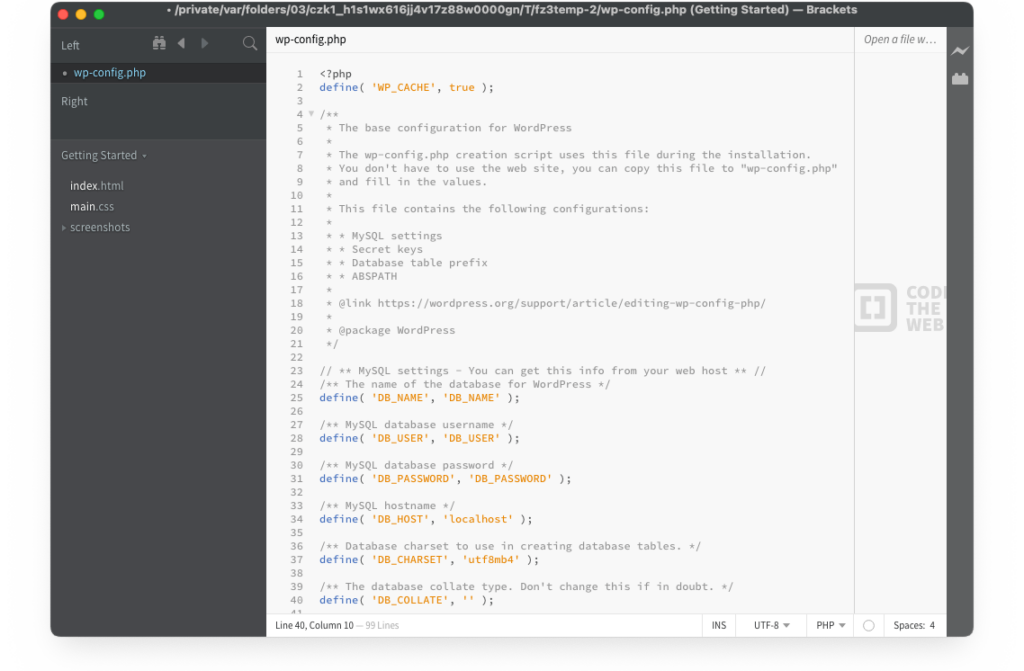
Attackers often target this file because it contains crucial information that can be exploited to gain full access to your site. If attackers access this file, it’s like handing them a roadmap to your site’s most vulnerable points. They can manipulate content, inject malicious JavaScript code, steal data, or even delete the entire website.
Best Practices and Solutions:
- Set the correct file permissions to ensure only necessary individuals or processes can read or modify wp-config.php.
- Move wp-config.php above the web root to prevent the file from being accessible via the web browser.
- Regularly back up the wp-config.php file and your entire website to enable quick recovery in case of mishaps.
- Use .htaccess rules to restrict access to wp-config.php by IP address, limiting access to trusted IPs only.
- Enhance encryption and security using WordPress security keys (secret keys) in the wp-config.php file.
- Disable PHP error reporting in production environments to prevent accidentally exposing sensitive information.
7. Insecure Permissions
In a WordPress environment, every file and directory has a set of permissions that dictate who can read, modify, or execute them. Properly configuring these permissions is crucial for your WordPress security. Incorrect permissions can allow unauthorized users or malicious scripts to alter your files, inject malicious code, or even take down your site.
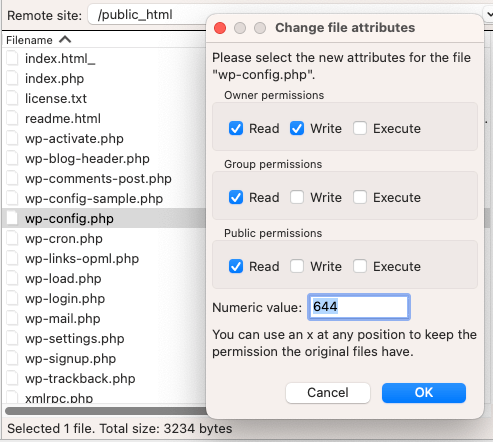
Overly generous permissions are like leaving your house’s doors wide open. They allow malicious actors easier access to inject code, remove files, or cause havoc on your site. For example, setting a file to 777 means anyone can read, write, and execute it, which is a significant security risk.
Best Practices and Solutions:
- Review and adjust file and directory permissions regularly, ensuring they’re as restrictive as possible without hindering your site’s functionality.
- Avoid the infamous “777” permission setting, which gives everyone read, write, and execute permissions — this is a massive security risk.
- Use WordPress security plugins or hosting services that can assist in correctly configuring permissions and alert you of any insecure settings.
- Set directory permissions to 755 and file permissions to 644 to balance usability and security.
- Limit access to critical files, such as wp-config.php, by setting more restrictive permissions (e.g., 600).
- Ensure that your web server user has the necessary permissions to read and write to the required files, but not more.
- Use .htaccess rules to restrict access to sensitive files and directories further.
8. Weak Passwords and Login Credentials
Weak passwords and poor login credentials management are major vulnerabilities that can make your site susceptible to brute-force attacks and unauthorized access. Attackers can quickly crack common, simple, or reused passwords, granting them access to your admin panel and sensitive data. Weak passwords are often short, lack complexity, and use predictable patterns such as “password123” or “admin2023.” Additionally, using default usernames like “admin” or failing to change login credentials after a breach increases the risk of unauthorized access.
Weak passwords and poor credential management undermine the security of even the most robust systems. Once an attacker gains access through weak credentials, they can compromise your site by altering content, stealing user data, injecting malware, or even taking down the site entirely. The consequences of such breaches can include loss of user trust, legal liabilities, and significant downtime, which can negatively impact your business and reputation.
Best Practices and Solutions:
- Ensure passwords are at least 12 characters long and include a mix of uppercase and lowercase letters, numbers, and symbols.
- Use reputable password managers like Bitwarden or KeePass to securely generate and store complex passwords.
- Regularly update passwords, especially for critical accounts like the WordPress admin.
- Implement two-factor authentication (2FA) for an extra layer of security during logins.
- Avoid using common usernames like “admin” and create unique usernames for all accounts.
- Change login credentials immediately after a breach or suspected compromise.
9. Low-Quality Hosting
While it’s tempting to opt for budget-friendly hosting solutions, especially when starting out, this decision can have significant drawbacks. Cheap or shared hosting often means you’re sharing resources with countless other sites. If any of those sites is compromised, yours could also be at risk. Additionally, low-quality hosts might not prioritize security features or regular backups, leaving your website vulnerable to attacks or data loss.
On the other hand, managed WordPress hosting or Virtual Private Server (VPS) solutions offer a more tailored environment for WordPress sites. These options typically include enhanced security protocols, faster performance, and dedicated resources. Investing in quality hosting is like investing in a solid foundation for a building—it’s essential for long-term stability and safety.
Best Practices and Solutions:
- Research hosting providers thoroughly, prioritizing their security features and track record.
- Consider upgrading to managed WordPress hosting or VPS for enhanced security and performance.
- Regularly back up your website, either through your hosting provider or using dedicated backup WordPress plugins.
- Ensure your hosting provider offers features like SSL certificates, regular malware scanning, and DDoS protection.
- Choose a host that provides 24/7 support to address any issues that arise quickly.
- Verify that the hosting provider has a good uptime record and a disaster recovery plan.
8 Security Threats Targeting WordPress Sites
WordPress, being one of the most popular content management systems, is a frequent target for cyberattacks. From malware and brute force attacks to phishing and SEO spam, these threats can compromise site integrity, steal sensitive information, and disrupt your online presence.
Let’s examine the most common security threats targeting WordPress sites, highlight their implications, and offer strategies for protecting against them.
1. Brute Force Attacks
Brute-force attacks involve hackers relentlessly trying every possible combination of usernames and passwords to guess your login credentials. These attacks are typically automated using scripts or bots, which can attempt thousands or even millions of login combinations quickly. The goal is to eventually find the correct combination to gain unauthorized access to your WordPress admin panel or other protected site areas.
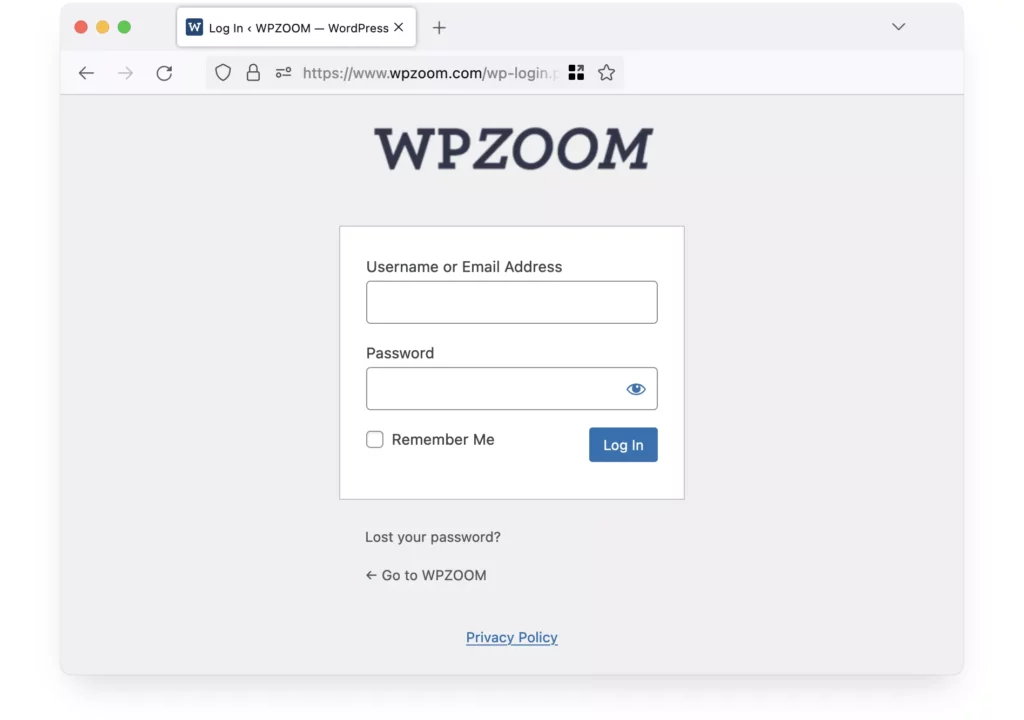
Brute force attacks exploit weak passwords, common usernames, and predictable credential patterns. They can lead to multiple issues, such as server overload due to many login attempts, account lockouts for legitimate users, and ultimately unauthorized access if a correct combination is guessed. This unauthorized access can then be used to steal sensitive information, inject malicious code, or take control of the entire site.
The persistent nature of brute force attacks makes them a significant threat, especially for sites that do not implement proper security measures. Attackers often target admin accounts or other user accounts with elevated privileges, as gaining access can provide full control over the site.
Best Practices and Solutions:
- Limit login attempts to reduce the chances of success.
- Use plugins to set restrictions on login attempts.
- Implement CAPTCHA on login pages to deter automated attacks.
- Monitor login attempts and set up alerts for suspicious activity.
- Use security plugins that can block IP addresses after a set number of failed login attempts.
2. Malware and Viruses
Malware, short for malicious software, is designed to infiltrate, damage, or exploit any device, network, service, or program. A virus is a specific type of malware that attaches itself to clean files and spreads throughout computer systems. On a WordPress site, common types of malware include backdoors, unexpected downloads, and malicious redirects.
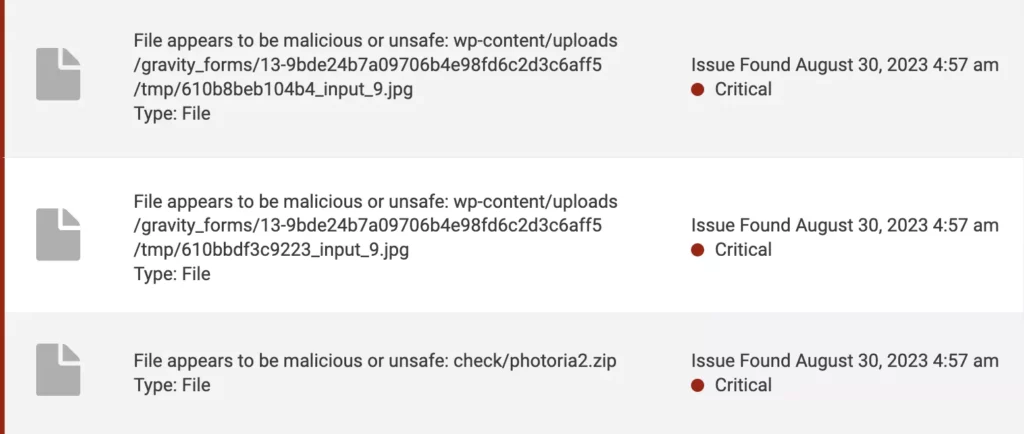
WordPress users often encounter malware disguised as plugins or themes. Even legitimate software can be compromised if not sourced from reputable developers or platforms. Malware can also be injected through outdated plugins or theme vulnerabilities, unsecured file permissions, or compromised admin accounts.
Malware and viruses can pose numerous dangers to WordPress websites. They can lead to a complete site takeover, leaving you powerless over your content. Worse, they can steal sensitive user data, harming your visitors and reputation.
Best Practices and Solutions:
- Implement a Web Application Firewall (WAF) to block malicious traffic before it reaches your site.
- Regularly scan your website for malware using trusted WordPress malware removal plugins.
- Only download plugins and themes from reputable sources, like the official WordPress repository.
- Keep your WordPress core, themes, and plugins updated to patch known vulnerabilities.
- Limit file permissions to only those necessary for the website to function.
- Regularly back up your website to quickly restore it in case of a malware infection.
- Educate yourself and your team about common phishing and social engineering attacks to prevent admin account compromises.
3. Cross-Site Scripting (XSS) Attacks
Cross-Site Scripting, commonly known as XSS, is a WordPress security vulnerability in which attackers inject malicious scripts into web pages viewed by users. Unlike other attacks that target the website itself, cross-site scripting targets the website’s users. When a user interacts with a compromised page, the malicious script runs, potentially accessing cookies, session tokens, or other sensitive information from the user’s browser.
XSS vulnerabilities can be introduced through various entry points, such as comment forms, search fields, and user-generated content. Attackers exploit these entry points by injecting malicious scripts that execute when the page is viewed by other users.
The implications of a cross-site scripting attack are far-reaching. Attackers can steal user browser data, impersonate victims, or redirect users to malicious websites. Given their stealthy nature, these attacks often go unnoticed until significant damage has been done.
Best Practices and Solutions:
- Use a WordPress security plugin or a Web Application Firewall (WAF) service that offers real-time monitoring and protection against XSS vulnerabilities.
- Regularly clean and validate all inputs, outputs, and data that your website processes.
- Educate yourself and any site administrators about the risks of cross-site scripting (XSS).
- Implement Content Security Policy (CSP) headers to restrict the sources from which scripts can be loaded on your website.
- Use secure coding practices, such as escaping output and sanitizing input, to minimize the risk of XSS vulnerabilities.
- Regularly audit your website’s codebase for potential vulnerabilities and address them promptly.
- Conduct regular penetration testing to identify and fix XSS vulnerabilities before attackers can exploit them.
4. DDoS Attacks
DDoS, which stands for Distributed Denial of Service, is an attack where multiple compromised systems, often part of a botnet, are used to flood a target, typically a web server, with an overwhelming amount of traffic. The primary aim is to exhaust the server’s resources, causing it to become inaccessible to legitimate users. These attacks can vary in intensity and duration, from brief disruptions to prolonged assaults that can cripple a site for hours or even days.
Successful DDoS attacks can have severe ramifications. Beyond interrupted service, a DDoS attack can severely hurt website performance, and prolonged attacks can lead to significant downtimes. For businesses, this translates to lost revenue, damaged reputation, and frustrated users. Additionally, repeated attacks can lead to increased bandwidth and security measures costs.
Best Practices and Solutions:
- Consider using Content Delivery Networks (CDNs) like Cloudflare or Akamai, which offer built-in protection against DDoS attacks.
- Monitor your website’s traffic patterns regularly to detect any unusual spikes, which might indicate the beginnings of a Distributed denial-of-service attack.
- Invest in specialized DDoS protection services or tools to help absorb and disperse malicious traffic.
- Ensure your hosting provider includes DDoS protection as part of their service.
- Implement rate limiting to control the number of requests your server can handle at a time.
- Use load balancers to distribute traffic evenly across multiple servers, reducing the impact of a DDoS attack.
- Maintain a plan for emergency response to address and mitigate the effects of a DDoS attack quickly.
5. Cross‑Site Request Forgery (CSRF) Attacks
Cross-Site Request Forgery (CSRF) attacks trick users into performing actions they did not intend to do by exploiting their authenticated session with a website. This can result in unauthorized actions, such as changing account details, making transactions, or altering site settings. Attackers create malicious links or scripts that, when executed by an unsuspecting user, carry out these actions without their consent or knowledge.
CSRF attacks rely on a website’s trust in the user’s browser. Since the user is already authenticated, the website believes the actions are legitimate. This can lead to significant security breaches, especially if the affected user has administrative privileges.
Best Practices and Solutions:
- Ensure that forms and state-changing requests include unique, secret tokens.
- Configure cookies with the SameSite attribute to prevent cross-site requests.
- Require users to re-enter their password for sensitive actions.
- Use security plugins that offer CSRF protection.
- Check the origin and referrer headers of incoming requests.
6. SQL Injections
SQL injections are a critical web security issue where attackers exploit a website’s structure vulnerabilities. They manipulate a website’s PHP code to inject malicious SQL commands into database queries. This manipulation causes the MySQL database to execute these harmful instructions instead of its intended functions.
The consequences of SQL injections can be severe. Attackers can exploit these vulnerabilities to gain unauthorized access, allowing them to view, edit, delete, or even add new data to the system. This breach can lead to viewing sensitive user details, altering essential site content, or bringing the whole website down, resulting in significant malfunctions or privacy invasions. Beyond immediate damage, a successful SQL injection attack can severely undermine user trust and damage your website’s reputation.
Best Practices and Solutions:
- Clean inputs to ensure that any data introduced into your website, whether through forms, URL parameters, or other means, is thoroughly sanitized to remove harmful elements.
- Use prepared statements and parameterized queries to ensure your SQL database isn’t directly susceptible to malicious user inputs.
- Ensure that the database user account used by your website has the minimal necessary permissions.
7. SEO Spam
One subtle but damaging form of attack on WordPress sites is Search Engine Optimization spam. In this attack, hackers inject spammy content or malicious links into your website, often concealing them so regular visitors don’t notice. These injections might promote unrelated products, link to malicious sites, or contain keyword-stuffed content to manipulate search engine rankings.
The consequences of SEO spam aren’t just aesthetic. SEO spam can seriously harm a website’s reputation with search engines. As search engines identify these spammy elements, they may lower the site’s ranking. In extreme cases, a site might be removed from search results altogether, leading to decreased organic traffic and a loss of credibility.
Best Practices and Solutions:
- Monitor search engine rankings and site statistics for sudden drops or unexpected keywords.
- Regularly review your site content, especially user-generated content, for any unfamiliar or suspicious links and text.
- Implement content moderation tools to review user-generated content before it goes live on your site.
8. Phishing
Phishing is a deceptive tactic where attackers trick individuals into revealing sensitive information, such as login credentials or personal data, by pretending to be trustworthy. In the WordPress ecosystem, this could manifest as fake plugin update alerts, misleading admin login prompts, counterfeit emails that appear to be from legitimate sources, or even malicious links embedded in comments or social engineering tactics.
Phishing attacks typically occur through emails, messages, or websites that appear legitimate but are designed to deceive users. Attackers may create replica websites that mimic the appearance of trusted sites or send emails that seem to come from official sources but contain links to malicious sites.
When users fall for these tactics, they’re essentially handing over the keys to their website, enabling attackers to seize control, steal data, or commit various other malicious acts. Phishing attacks can lead to unauthorized access to your site, data breaches, and significant damage to your website’s reputation and trustworthiness.
Best Practices and Solutions:
- Always double-check the URL when logging into your WordPress site. Phishing sites might look identical but will have a different or suspicious URL.
- Be cautious of unsolicited communications urging immediate action, such as unexpected password resets or plugin updates from unfamiliar sources.
- Check the official website of WordPress plugin or theme developers for updates or announcements to verify the authenticity of emails or messages received.
- Use email filtering tools to detect and block phishing attempts.
Conclusion
WordPress security is an ongoing process that requires vigilance and proactive measures to protect against various vulnerabilities and threats.
By understanding the common security issues within WordPress, such as outdated software and weak passwords, and recognizing external threats like malware and phishing, site owners can implement effective strategies to safeguard their websites. Regular updates, robust security plugins, strong password policies, and reliable backups are essential to a comprehensive security plan.
Maintaining a secure WordPress site ensures a safe and trustworthy environment for users, helping protect valuable data and sustain your site’s reputation.
